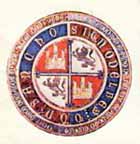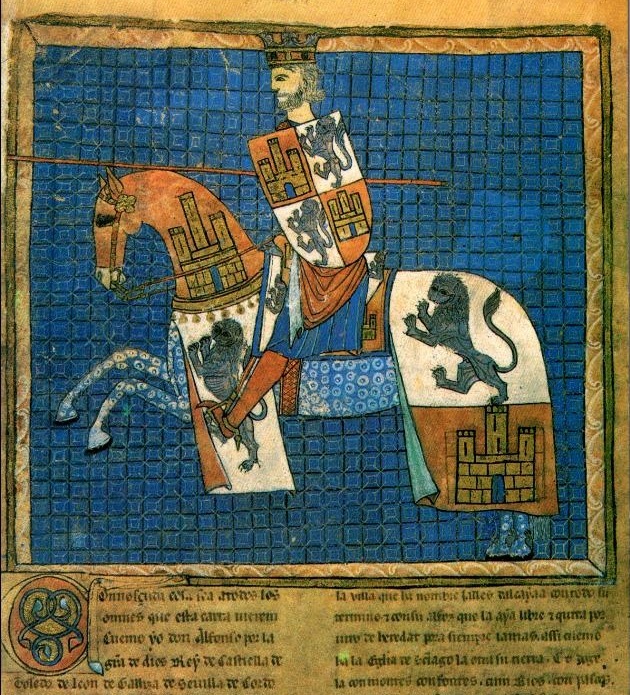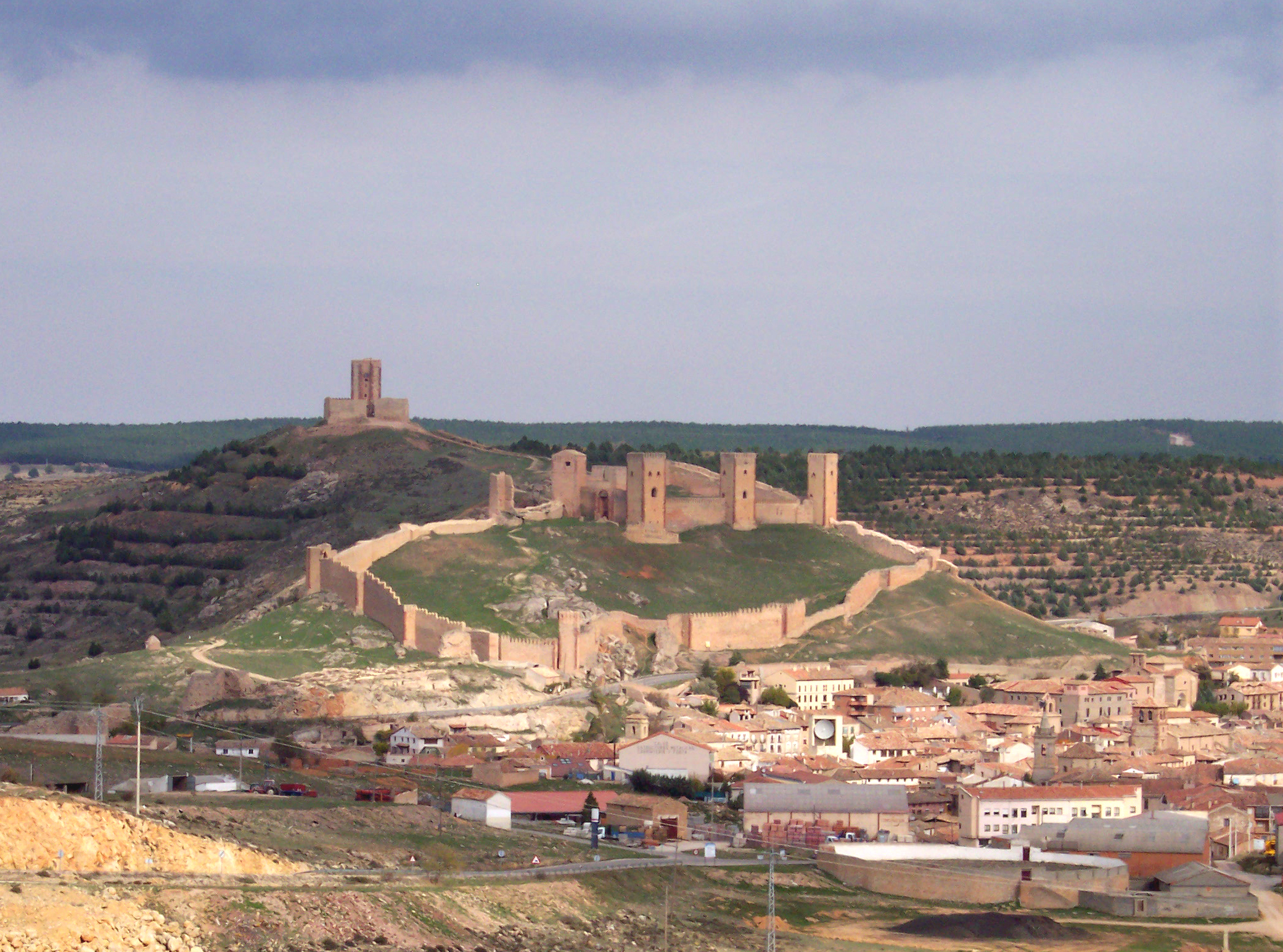|
Aldonza Martínez De Silva
Aldonza Martínez de Silva (Portuguese language, Portuguese: Aldonça Martins da Silva; died after 1236) a Portuguese noblewoman, daughter of Martim Gomes da Silva and his wife Urraca Rodríguez, was one of the mistresses of King Alfonso IX of León and afterward, the wife of Diego Froilaz. She probably arrived in the Kingdom of León in 1191 in the entourage of ''Infanta'' Theresa of Portugal, Queen of León, Theresa of Portugal for her wedding with King Alfonso IX. She had very influential relatives in the Kingdom of Portugal, including her aunt, Estefanía da Silva and her husband Martim Fernandes de Riba de Vizela, who were the tutors of the future King Sancho II of Portugal, and Estêvão Soares da Silva, the powerful Roman Catholic Archdiocese of Braga#List of Archbishops of Braga, Archbishop of Braga. In 1214 she became the lover of Alfonso IX in a relationship that lasted until 1218 when the king became involved with Teresa Gil de Soverosa. Afterwards, she married Diego F ... [...More Info...] [...Related Items...] OR: [Wikipedia] [Google] [Baidu] |
Carracedo (Le) - Monasterio De Santa Maria 14
The Monastery of Saint Mary of Carracedo or the Monasterio de Santa María de Carracedo is an inactive abbey and palace complex, now in semi-restored state near the town of Carracedelo, province of León, Castile and León, Spain. Founded in the tenth century by the Benedictine order, it lies near the Camino de Santiago, Way of Santiago in Northern Spain. The first cenobite, cenobitic community, the Monastery of San Salvador, was founded here around the year 990 by Bermudo II of León, Bermudo II, King of Kingdom of León, León and Kingdom of Galicia, Galicia, with the principal aim of sheltering monks seeking refuge from the campaigns of the Moors, Moorish general Almanzor. This, however, did not spare the monastery from being destroyed by Almanzor in his campaign of 997. In 1138, the ''Infanta'' Sancha Raimúndez, Sancha, sister of Alfonso VII of León, helped rebuild a monastery on the site, calling on monks from the neighboring Monastery of Santa María de Valverde near Co ... [...More Info...] [...Related Items...] OR: [Wikipedia] [Google] [Baidu] |
Alférez
In medieval Iberia, an ''alférez'' (, ) or ''alferes'' (, ) was a high-ranking official in the household of a king or magnate. The term is derived from the Arabic ('' al-fāris''), meaning "knight" or "cavalier", and it was commonly Latinised as ''alferiz'' or ''alferis'', although it was also translated into Latin as ''armiger'' or ''armentarius'', meaning " armour-bearer". The connection with arms-bearing is visible in several Latin synonyms: ''fertorarius'', ''inferartis'', and ''offertor''. The office was sometimes the same as that of the standard-bearer or ''signifer''.Simon Barton, ''The Aristocracy in Twelfth-century León and Castile'' (Cambridge, 1997), 142–44. The ''alférez'' was generally the next highest-ranking official after the majordomo.Simon Barton, ''The Aristocracy in Twelfth-century León and Castile'' (Cambridge, 1997), 59. He was generally in charge of the king or magnate's ''mesnada'' (private army), his personal retinue of knights, and perhaps also of ... [...More Info...] [...Related Items...] OR: [Wikipedia] [Google] [Baidu] |
María De Molina
María Alfonso Téllez de Meneses (c. 1265 – 1321), known as María de Molina, was queen consort of Kingdom of Castile, Castile and Kingdom of León, León from 1284 to 1295 by marriage to Sancho IV of Castile, and served as regent for her minor son Ferdinand IV of Castile, Ferdinand IV (1295 - c.1301) and later her grandson Alfonso XI of Castile (1312-1321). Queenship María was the daughter of the ''infante'' Alfonso of Molina and Mayor Alfonso de Meneses. Her paternal grandparents were King Alfonso IX of León and Queen Berengaria of Castile. She married her first cousin-once removed Sancho IV of Castile, Sancho in 1282, although the matrimonial dispensation for kinship was not previously granted. Upon the death of his father, Alfonso X, the couple became king and queen of Castile and León. She was crowned alongside her husband in the cathedral of Toledo. Although the couple was pressured to separate by Rome and others, Sancho chose to honor his wife and delegated many re ... [...More Info...] [...Related Items...] OR: [Wikipedia] [Google] [Baidu] |
Sancho IV Of Castile
Sancho IV of Castile (12 May 1258 – 25 April 1295) called the Brave (''el Bravo''), was the king of Castile, León and Galicia (now parts of Spain) from 1284 to his death. Following his brother Ferdinand's death, he gained the support of nobles who declared him king instead of Ferdinand's son Alfonso. Faced with revolts throughout his reign, before he died he made his wife regent for his son, who became Ferdinand IV. Biography Sancho was the second son of Alfonso X and Yolanda, daughter of James I of Aragon. His elder brother, Ferdinand de la Cerda, died in November 1275. In 1282 Sancho assembled a coalition of nobles to declare for him against Ferdinand's son Alfonso, then took control of the kingdom when Alfonso X died in 1284. This was all against the wishes of their father, but Sancho was crowned in Toledo nevertheless. Sancho's ascension was in part due to his rejection of his father's elitist politics. Sancho was recognised and supported by the majo ... [...More Info...] [...Related Items...] OR: [Wikipedia] [Google] [Baidu] |
Ferdinand II Of León
Ferdinand II ( 1137 – 22 January 1188), was a member of the Castilian House of Burgundy, Castilian cadet branch of the House of Ivrea and List of Leonese monarchs, King of León and kingdom of Galicia, Galicia from 1157 until his death. Life Family Born in Toledo, Spain, Toledo, Castile (historical region), Castile, Ferdinand was the third but second surviving son of King Alfonso VII of León and Castile and Berenguela of Barcelona. His paternal grandparents were Count Raymond of Burgundy and Queen Urraca of León and his maternal grandparents were Ramon Berenguer III, Count of Barcelona, and Douce I, Countess of Provence. He had seven full-siblings, of whom only three survived infancy: the later King Sancho III of Castile, Constance of Castile, Constance (wife of King Louis VII of France) and Sancha of Castile, Queen of Navarre, Sancha (wife of King Sancho VI of Navarre), and two half-siblings from his father's second marriage with Richeza of Poland, Queen of Castile, Richeza ... [...More Info...] [...Related Items...] OR: [Wikipedia] [Google] [Baidu] |
Ferdinand IV Of Castile
Ferdinand IV of Castile (6 December 1285 – 7 September 1312) called the Summoned (''el Emplazado''), was King of Castile and King of León, León from 1295 until his death. Ferdinand's upbringing and personal custody was entered to his mother Queen María de Molina, however, he was tutored by his granduncle Henry of Castile the Senator. Queen María attempted to placate the nobility, confronted her son's enemies, and repeated prevented her son from being dethroned. He faced the insubordination of the nobility, led at numerous times by his uncle John of Castile, Lord of Valencia de Campos, and by Juan Núñez II de Lara, who were sometimes supported by another royal relative, Juan Manuel, Prince of Villena. Like his predecessors on the throne, Ferdinand IV continued the Reconquista and, although he failed to conquer Algeciras in 1309, he captured the city of Gibraltar that same year. In 1312 the city of Alcaudete was also conquered. During the Cortes of Valladolid of 1312, he p ... [...More Info...] [...Related Items...] OR: [Wikipedia] [Google] [Baidu] |
Alfonso X Of Castile
Alfonso X (also known as the Wise, ; 23 November 1221 – 4 April 1284) was King of Castile, Kingdom of León, León and Kingdom of Galicia, Galicia from 1 June 1252 until his death in 1284. During the April 1257 Imperial election, election of 1257, a dissident faction chose him to be king of Germany on 1 April. He renounced his claim to Germany in 1275, and in creating an alliance with the Kingdom of England in 1254, his claim on the Duchy of Gascony as well. Alfonso's scientific interests—he is sometimes nicknamed the Astrologer (''el Astrólogo'')—led him to sponsor the creation of the Alfonsine tables, and the Alphonsus (crater), Alphonsus crater on the Moon is named after him. He also sponsored the work of historians who, for the first time since Isidore of Seville in , placed Spain in the context of world history. As a lawmaker he introduced the first vernacular law code in Castile, the ''Siete Partidas''. He created the Mesta, an association of sheep farmers in the cen ... [...More Info...] [...Related Items...] OR: [Wikipedia] [Google] [Baidu] |
Alfonso Of Molina
Alfonso of León, Lord of Molina (1202 – 6 January 1272) was an ''infante'' (prince) of León and Castile, the son of King Alfonso IX of León and his second wife Queen Berengaria of Castile. He was the brother of King Ferdinand III of Castile and León, and father of Queen Maria of Molina, wife of King Sancho IV. He became Lord of Molina and Mesa after his first marriage to Mafalda González de Lara, the heiress of those lands. Family origins Alfonso was the son of King Alfonso IX of León and his second wife, Queen Berengaria of Castile. On his father's side he was the grandson of King Ferdinand II of León and his first wife, Urraca of Portugal. On his mother's side his grandparents were King Alfonso VIII of Castile and his wife, Eleanor of England. His siblings included King Ferdinand III of Castile and León, Berengaria, Constance, and Eleanor. Biography Alfonso was born near León in 1202. As the son of Alfonso IX of León and Berengaria of Castile, he witnessed th ... [...More Info...] [...Related Items...] OR: [Wikipedia] [Google] [Baidu] |
Pedro Alfonso De León
Pedro Alfonso de León (c. 1196 – 1226) was a Leonese Spanish noble of the House of Burgundy. He was, according to many historians, the illegitimate son of Alfonso IX of León. He was elected Grand Master of the Order of Santiago in 1225, succeeding Fernán Pérez Chacín in the role. Biography His exact date of birth is not known, but is estimated to be around 1196. There is also controversy amongst historians surrounding his true identity. Some chroniclers hold that he was the illegitimate son of Alfonso IX of León and an unknown woman, while others maintain that his mother was Aldonza Martínez de Silva, daughter of Martín Gómez de Silva and his wife Urraca Ruiz de Cabrera. Still other historians have cast doubt on Pedro Alfonso's status as Alfonso IX's illegitimate son, that he existed at all or that he was a Grand Master of the Order of Santiago. Marriage and descendancy The name of his wife is not known, and historians disagree over whether Pedro Alfonso had one ... [...More Info...] [...Related Items...] OR: [Wikipedia] [Google] [Baidu] |
Luis De Salazar Y Castro
Luis Bartolomé de Salazar y Castro (September 4, 1658 – 1734) was a Spanish Genealogy, genealogist. Called by some the "prince of genealogists," he is one of the most cited Spanish chroniclers. The collection of documents he gathered throughout his life, preserved in the Real Academia de la Historia, Royal Academy of History of Spain, is one of the basic sources for the research of Iberian Peninsula, Iberian lineages. Spanish genealogists People from Valladolid 1658 births 1734 deaths {{Spain-bio-stub ... [...More Info...] [...Related Items...] OR: [Wikipedia] [Google] [Baidu] |
Pedro Afonso, Count Of Barcelos
Pedro Afonso, Count of Barcelos (before 1289 – 1354), was an illegitimate son of King Denis of Portugal and Grácia Froes. He was made the 3rd Count of Barcelos on 1 May 1314. Biography Much like the other illegitimate children of King Denis, Pedro Afonso was raised by Queen Elizabeth of Portugal along with his half-brothers and half-sisters at court. The children were sent at an early age to live there as a political, not charitable necessity, as they were seen as a method of cementing alliances and creating a network of influence within the courts of Europe. King Denis in his October 1298 will stated that the Queen would specifically administer and instruct his illegitimate children, and provided that they would be disinherited if they were to dishonour or disobey the authority of Infante Afonso. The Count always counted on the protection and support of his father, receiving dominion over lands in Lisbon, Estremoz, Evoramonte, Sintra and Tavira, among others. He soon beca ... [...More Info...] [...Related Items...] OR: [Wikipedia] [Google] [Baidu] |
House Of Lara
The House of Lara (Spanish: ''Casa de Lara'') is a noble family from the medieval Kingdom of Castile. Two of its branches, one of the Dukes of Nájera and one of the Marquises of Aguilar de Campoo were considered Grandees of Spain. The Lara family gained numerous territories in Castile, León, Andalucía, and Galicia and members of the family moved throughout the former Spanish colonies, establishing branches as far away as the Philippines and Argentina. The House of Lara were most prominent in the history of Castile and León from the 11th to the 14th century. Álvaro Núñez de Lara served as regent for Henry I of Castile. They were dispossessed of much of their land by Peter the Cruel, but most was returned by Henry II. History The family arose in 11th century Castile through a marriage that united the paternal lands around Lara de los Infantes belonging to Gonzalo Núñez with the inheritance of his wife, Goto Núñez, representing the holdings of the noble Álva ... [...More Info...] [...Related Items...] OR: [Wikipedia] [Google] [Baidu] |



